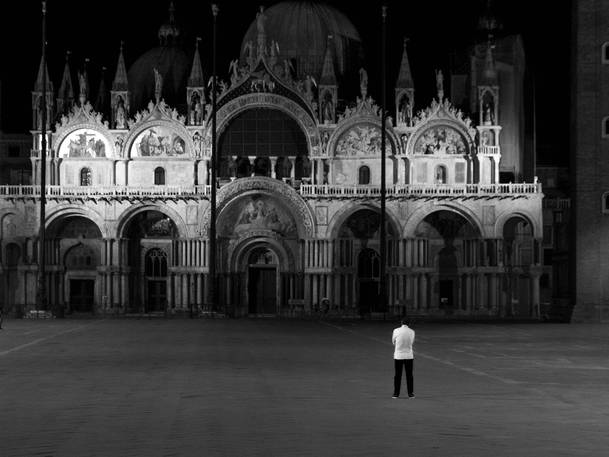


ROME -- Tourism to the lagoon city shows no let-up: an Airbnb report in late May showed that for every inhabitant in Venice there are 73.8 tourists, for between 23 million and 28 million tourists a year. As a result, the battle against the big ships that overwhelm Venice and its canals with tourists is being fought by politicians and groups of irate citizens. But it is also being fought in photographs and books that celebrate the city and its traditions.
The photographs are particularly intimate and eloquent, for their creators -- Italian and foreign -- seek out the most evocative of the old ways and byways. Newest of these is "Dream of Venice in Black and White," an anthology of outstanding photos with an introduction by Tiziano Scarpa, Venetian-born poet and playwright whose novel "Stabat Mater" won the Strega Prize for literature in 2009. Editor is JoAnn Locktov, founder of Bella Publications, which published "Dream of Venice" as the third in a trilogy on the lagoon city architecture and arts.
Venice, writer Scarpa reminds us, lost its power and wealth when commerce and business moved from the Mediterranean to the Atlantic. "Venice had to reinvent itself, little by little, from the seventeenth century, until it became a sort of Las Vegas or Broadway," he writes. It launched the cafe society trend, invented the business of grand opera, established gambling houses and offered "prostitution to suit all tastes, but also churches with high-quality orchestras," among whose musicians was Antonio Vivaldi. Even its famous Carnival was business, meant to attract foreigners given permission to walk around in masks: "Venice tried in every way to make its guests spend as much as possible."
For literally a century, Venice made a living from its oil refineries and chemical industries, but in recent decades globalism took its toll, whittling away at this source of revenue. Keeping the city alive today is what Scarpa calls the "foreigner industry." By this he means that not only objects like pieces of glass, but the Venetians themselves are being replaced with actual foreigners in shops, homes and financial activities. "So what can you do about it?" Scarpa asks. One way, he suggests, is to stay at home and leaf through books such as "Dream of Venice," which make the city "bloom with a light caress made up of splendid images."
Writers too celebrate that authentic Venice. An example: the anthology of essays on Venice "The First Spritz is Free, Confessions of Venice Addicts," edited and published by Kathleen Ann Gonzalez, the author of "Free Gondola Ride," about the gondoliers of Venice. A sampler of tantalizing chapter titles from "First Spritz": "Venice, Mirror of the Soul," by Manuel Carrion; "Venice, A Comfy Cocoon" by Mayumi Hayashi; "You Have to Get Lost, by Luisella Romeo; and "Finding Titian's House," by Frederick Ilchman." For how to obtain a free download, go to ; print copies are available as well through Amazon and the like >> [2](True confession: one of its 35 chapters is my own.)
Contrasting these photographic and verbal images are those showing the huge ships which drop literally thousands of tourists, all at the same time, into the narrow streets for brief stays. The fight against them continues: last month the mayor decided to promote Mestre as an alternative tourism mecca. Some 53,000 locals still live on the island, but much of what was once familiar has disappeared from their lives including food shops, replaced by huge new hotels, art galleries, stores selling Venetian-replica glass made in China. In the meantime prosecutors are investigating the results of the costly construction of the Mose, a movable steel dam that was supposed to deal with the problem of high water but has so far never functioned and seems unlikely to do so.
Businessman Luigi Brugnaro, mayor since 2015 with the backing of a center-right coalition, is the former president of Assolavoro, an association that is part of Confindustria. Last June demonstrations against what some call the "giants of the sea" were held, and in a scathing tweet Brugnaro commented that only 500 to 800 people participated, "many of whom came from outside of Venice.... You kept @comunevenezia for years under the blackmail of your manifestations. We think differently."
Nevertheless, in a recent interview with Nuova Venezia Brugnaro said that, "We have been saying for a long time that these big ships must not pass through the Giudecca Canal. It's time to go ahead with the project for a new maritime port at Marghera." In fact, regional and government funds are already slated for improvements to that port and to a canal leading into it, preparing it to receive the mega-cruise ships. And just in time: Venice tourism continues to grow unchecked, and at Mestre foreign investors have put $81.4 million into new hotels that will accommodate 1,900 visitors. In addition, ordinary maintenance in Venice is complex. On Sept. 13 it was announced that 4 million have been set aside for excavating 4 km of canals, to be freed of 15,000 cubic meters of mud. Already seven canals (rii) were cleaned at the cost of $1.2 million.
__________
Judith Harris is the author of Evelina: "A Victorian Heroine in Venice" (Fonthill Media, 2017)
Source URL: http://newsite.iitaly.org/magazine/focus/art-culture/article/writers-photographers-fight-keep-venice-alive-and-authentic
Links
[1] http://newsite.iitaly.org/files/2dream-venice-eugenio-novajra-pg66-72jpg-0
[2] https://seductivevenice.wordpress.com/2018/07/02/first-spritz-is-free-is-launched